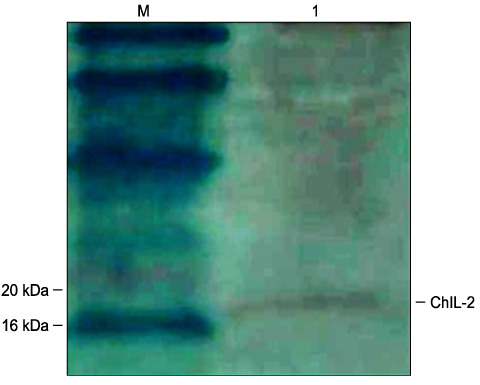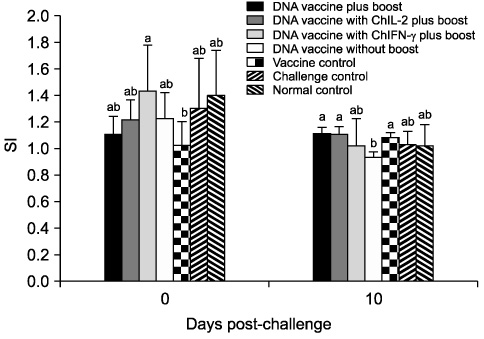J Vet Sci.
2009 Jun;10(2):131-139. 10.4142/jvs.2009.10.2.131.
Protection of chicken against very virulent IBDV provided by in ovo priming with DNA vaccine and boosting with killed vaccine and the adjuvant effects of plasmid-encoded chicken interleukin-2 and interferon-gamma
- Affiliations
-
- 1Laboratory of Veterinary Microbiology, School of Veterinary Medicine and Institute of Veterinary Science, Kangwon National University, Chuncheon 200-701, Korea. kwonhm@kangwon.ac.kr
- KMID: 1102969
- DOI: http://doi.org/10.4142/jvs.2009.10.2.131
Abstract
- The aim of this study was to examine the efficacy of in ovo prime-boost vaccination against infectious bursal disease virus (IBDV) using a DNA vaccine to prime in ovo followed by a killed-vaccine boost post hatching. In addition, the adjuvant effects of plasmid-encoded chicken interleukin-2 and chicken interferon-gamma were tested in conjunction with the vaccine. A plasmid DNA vaccine (pcDNA-VP243) encoding the VP2, VP4, and VP3 proteins of the very virulent IBDV (vvIBDV) SH/92 strain was injected into the amniotic sac alone or in combination with a plasmid encoding chicken IL-2 (ChIL-2) or chicken IFN-gamma (ChIFN-gamma) at embryonation day 18, followed by an intramuscular injection of a commercial killed IBD vaccine at 1 week of age. The chickens were orally challenged with the vvIBDV SH/92 strain at 3 weeks of age and observed for 10 days. In ovo DNA immunization followed by a killed-vaccine boost provided significantly better immunity than the other options. No mortality was observed in this group after a challenge with the vvIBDV. The prime-boost strategy was moderately effective against bursal damage, which was measured by the bursa weight/body weight ratio, the presence of IBDV RNA, and the bursal lesion score. In ovo DNA vaccination with no boost did not provide sufficient immunity, and the addition of ChIL-2 or ChIFN-gamma did not enhance protective immunity. In the ConA-induced lymphocyte proliferation assay of peripheral blood lymphocyte collected 10 days post-challenge, there was greater proliferation responses in the DNA vaccine plus boost and DNA vaccine with ChIL-2 plus boost groups compared to the other groups. These findings suggest that priming with DNA vaccine and boosting with killed vaccine is an effective strategy for protecting chickens against vvIBDV.
Keyword
MeSH Terms
-
Adjuvants, Immunologic/pharmacology
Animals
Antibodies, Viral/blood
Birnaviridae Infections/immunology/prevention & control/*veterinary/virology
Body Weight/immunology
Bursa of Fabricius/immunology
Chick Embryo
*Chickens
Histocytochemistry/veterinary
Immunization/*veterinary
Infectious bursal disease virus/genetics/*immunology
Interferon-gamma/pharmacology
Interleukin-2/pharmacology
Organ Size/immunology
Poultry Diseases/immunology/*prevention & control/virology
RNA, Viral/chemistry/genetics
Random Allocation
Reverse Transcriptase Polymerase Chain Reaction/veterinary
Specific Pathogen-Free Organisms
Vaccines, DNA/*administration & dosage/immunology
Vaccines, Inactivated/administration & dosage/immunology
Viral Vaccines/*administration & dosage/immunology
Figure
Cited by 1 articles
Reference
-
1. Asif M, Jenkins KA, Hilton LS, Kimpton WG, Bean AG, Lowenthal JW. Cytokines as adjuvants for avian vaccines. Immunol Cell Biol. 2004. 82:638–643.
Article2. Chang HC, Lin TL, Wu CC. DNA-mediated vaccination against infectious bursal disease in chickens. Vaccine. 2001. 20:328–335.
Article3. Chang HC, Lin TL, Wu CC. DNA vaccination with plasmids containing various fragments of large segment genome of infectious bursal disease virus. Vaccine. 2003. 21:507–513.
Article4. Coletti M, Del Rossi E, Franciosini MP, Passamonti F, Tacconi G, Marini C. Efficacy and safety of an infectious bursal disease virus intermediate vaccine in ovo. Avian Dis. 2001. 45:1036–1043.
Article5. Fahey KJ, Erny K, Crooks J. A conformational immunogen on VP-2 of infectious bursal disease virus that induces virus-neutralizing antibodies that passively protect chicken. J Gen Virol. 1989. 70:1473–1481.
Article6. Francois A, Chevalier C, Delmas B, Eterradossi N, Toquin D, Rivallan G, Langlois P. Avian adenovirus CELO recombinants expressing VP2 of infectious bursal disease virus induce protection against bursal disease in chickens. Vaccine. 2004. 22:2351–2360.
Article7. Harms JS, Oliveira SC, Splitter GA. Regulation of transgene expression in genetic immunization. Braz J Med Biol Res. 1999. 32:155–162.
Article8. Haygreen EA, Kaiser P, Burgess SC, Davison TF. In ovo DNA immunisation followed by a recombinant fowlpox boost is fully protective to challenge with virulent IBDV. Vaccine. 2006. 24:4951–4961.
Article9. Hicks CR, Turner KV. Fundamental Concepts in the Design of Experiments. 1996. New York: Oxford University Press;195–196.10. Hsieh MK, Wu CC, Lin TL. The effect of co-administration of DNA carrying chicken interferon-gamma gene on protection of chickens against infectious bursal disease by DNA-mediated vaccination. Vaccine. 2006. 24:6955–6965.
Article11. Hsieh MK, Wu CC, Lin TL. Priming with DNA vaccine and boosting with killed vaccine conferring protection of chickens against infectious bursal disease. Vaccine. 2007. 25:5417–5427.
Article12. Hulse DJ, Romero CH. Partial protection against infectious bursal disease virus through DNA-mediated vaccination with the VP2 capsid protein and chicken IL-2 genes. Vaccine. 2004. 22:1249–1259.
Article13. Kapczynski DR, Hilt DA, Shapiro D, Sellers HS, Jackwood MW. Protection of chickens from infectious bronchitis by in ovo and intramuscular vaccination with a DNA vaccine expressing the S1 glycoprotein. Avian Dis. 2003. 47:272–285.
Article14. Kibenge FSB, Dhillon AS, Russell RG. Biochemistry and immunology of infectious bursal disease virus. J Gen Virol. 1988. 69:1757–1775.
Article15. Kim SJ, Sung HW, Han JH, Jackwood D, Kwon HM. Protection against very virulent infectious bursal disease virus in chickens immunized with DNA vaccines. Vet Microbiol. 2004. 101:39–51.
Article16. Kozak M. At least six nucleotides preceding the AUG initiator codon enhance translation in mammalian cells. J Mol Biol. 1987. 196:947–950.
Article17. Kumar S, Ahi YS, Salunkhe SS, Koul M, Tiwari AK, Gupta PK, Rai A. Effective protection by high efficiency bicistronic DNA vaccine against infectious bursal disease virus expressing VP2 protein and chicken IL-2. Vaccine. 2009. 27:864–869.
Article18. Larsen DL, Karasin A, Olsen CW. Immunization of pigs against influenza virus infection by DNA vaccine priming followed by killed-virus vaccine boosting. Vaccine. 2001. 19:2842–2853.
Article19. Li Y, Stirling CM, Denyer MS, Hamblin P, Hutchings G, Takamatsu HH, Barnett PV. Dramatic improvement in FMD DNA vaccine efficacy and cross-serotype antibody induction in pigs following a protein boost. Vaccine. 2008. 26:2647–2656.
Article20. Lin Z, Kato A, Otaki Y, Nakamura T, Sasmaz E, Ueda S. Sequence comparisons of a highly virulent infectious bursal disease virus prevalent in Japan. Avian Dis. 1993. 37:315–323.
Article21. Lillehoj HS, Ding X, Quiroz MA, Bevensee E, Lillehoj EP. Resistance to intestinal coccidiosis following DNA immunization with the cloned 3-1E Eimeria gene plus IL-2, IL-15, and IFN-gamma. Avian Dis. 2005. 49:112–117.
Article22. Long JE, Huang LN, Qin ZQ, Wang WY, Qu D. IFN-gamma increases efficiency of DNA vaccine in protecting ducks against infection. World J Gastroenterol. 2005. 11:4967–4973.
Article23. Lukert PD, Saif YM. Saif YM, Barnes HJ, Fadly AM, Glisson JR, McDougald LR, Swayne DE, editors. Infectious bursal disease. Diseases of Poultry. 2003. Ames: Iowa State University Press;161–179.24. Mahmood MS, Siddique M, Hussain I, Khan A, Mansoor MK. Protection capability of recombinant plasmid DNA vaccine containing VP2 gene of very virulent infectious bursal disease virus in chickens adjuvanted with CpG oligodeoxynucleotide. Vaccine. 2006. 24:4838–4846.
Article25. Min W, Lillehoj HS, Burnside J, Weining KC, Staeheli P, Zhu JJ. Adjuvant effects of IL-1beta, IL-2, IL-8, IL-15, IFN-alpha, IFN-gamma TGF-beta4 and lymphotactin on DNA vaccination against Eimeria acervulina. Vaccine. 2001. 20:267–274.
Article26. Murphy FA, Fauquet CM, Bishop DHL, Ghabrial SA, Jarvis AW, Martelli GP, Mayo MA, Summers MD. Virus Taxonomy: Sixth Report of the International Committee on Taxonomy of Viruses. 1995. Wien: Springer-Verlag;240–244.27. Mundt E, Beyer J, Müller H. Identification of a novel viral protein in infectious bursal disease virus-infected cells. J Gen Virol. 1995. 76:437–443.
Article28. Negash T, al-Garib SO, Gruys E. Comparison of in ovo and post-hatch vaccination with particular reference to infectious bursal disease. A review. Vet Q. 2004. 26:76–87.
Article29. Oshop GL, Elankumaran S, Heckert RA. DNA vaccination in the avian. Vet Immunol Immunopathol. 2002. 89:1–12.
Article30. Ramshaw IA, Ramsay AJ. The prime-boost strategy: exciting prospects for improved vaccination. Immunol Today. 2000. 21:163–165.
Article31. Rautenschlein S, Yeh HY, Sharma JM. The role of T cells in protection by an inactivated infectious bursal disease virus vaccine. Vet Immunol Immunopathol. 2002. 89:159–167.
Article32. Roh HJ, Sung HW, Kwon HM. Effects of DDA, CpG-ODN, and plasmid-encoded chicken IFN-γ on protective immunity by a DNA vaccine against IBDV in Chickens. J Vet Sci. 2006. 7:361–368.
Article33. Sharma JM. Introduction to poultry vaccines and immunity. Adv Vet Med. 1999. 41:481–494.
Article34. Snyder DB, Vakharia VN, Savage PK. Naturally occurring-neutralizing monoclonal antibody escape variants define the epidemiology of infectious bursal disease viruses in the United States. Arch Virol. 1992. 127:89–101.
Article35. Stepaniak JA, Shuster JE, Hu W, Sundick RS. Production and in vitro characterization of recombinant chicken interleukin-2. J Interferon Cytokine Res. 1999. 19:515–526.
Article36. Sundick RS, Gill-Dixon C. A cloned chicken lymphokine homologous to both mammalian IL-2 and IL-15. J Immunol. 1997. 159:720–725.37. Tarpey I, van Loon AA, de Haas N, Davis PJ, Orbell S, Cavanagh D, Britton P, Casais R, Sondermeijer P, Sundick R. A recombinant turkey herpesvirus expressing chicken interleukin-2 increases the protection provided by in ovo vaccination with infectious bursal disease and infectious bronchitis virus. Vaccine. 2007. 25:8529–8535.
Article38. Tsukamoto K, Tanimura N, Kakita S, Ota K, Mase M, Imai K, Hihara H. Efficacy of three live vaccines against highly virulent infectious bursal disease virus in chickens with or without maternal antibodies. Avian Dis. 1995. 39:218–229.
Article39. Van den Berg TP, Gonze M, Meulemans G. Acute infectious bursal disease in poultry: Isolation and characterisation of a highly virulent strain. Avian Pathol. 1991. 20:133–143.
Article40. Yeh HY, Rautenschlein S, Sharma JM. Protective immunity against infectious bursal disease virus in chickens in the absence of virus-specific antibodies. Vet Immunol Immunopathol. 2002. 89:149–158.
Article
- Full Text Links
- Actions
-
Cited
- CITED
-
- Close
- Share
- Similar articles
-
- Effects of DDA, CpG-ODN, and plasmid-encoded chicken IFN-gamma on protective immunity by a DNA vaccine against IBDV in chickens
- Co-Immunization of Plasmid DNA Encoding IL-12 and IL-18 with Bacillus Calmette-Guerin Vaccine against Progressive Tuberculosis
- Influence of Immunity Induced at Priming Step on Mucosal Immunization of Heterologous Prime-Boost Regimens
- Modulation of Humoral and Cell-Mediated Immunity Against Avian Influenza and Newcastle Disease Vaccines by Oral Administration of Salmonella enterica Serovar Typhimurium Expressing Chicken Interleukin-18
- Protective effects and immunogenicity of Salmonella Enteritidis killed vaccine strains selected from virulent Salmonella Enteritidis isolates




